Printable Version of Topic
Click here to view this topic in its original format
914World.com _ 914World Garage _ Down In A Blaze Of Unglory - 914s on FIRE!
Posted by: tumamilhem Dec 4 2012, 02:32 PM
Has this ever happened to you? 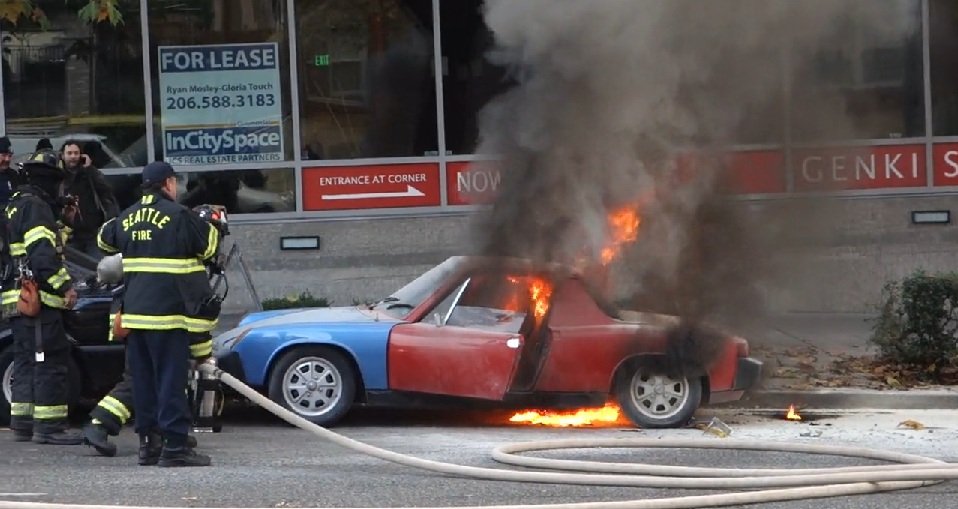
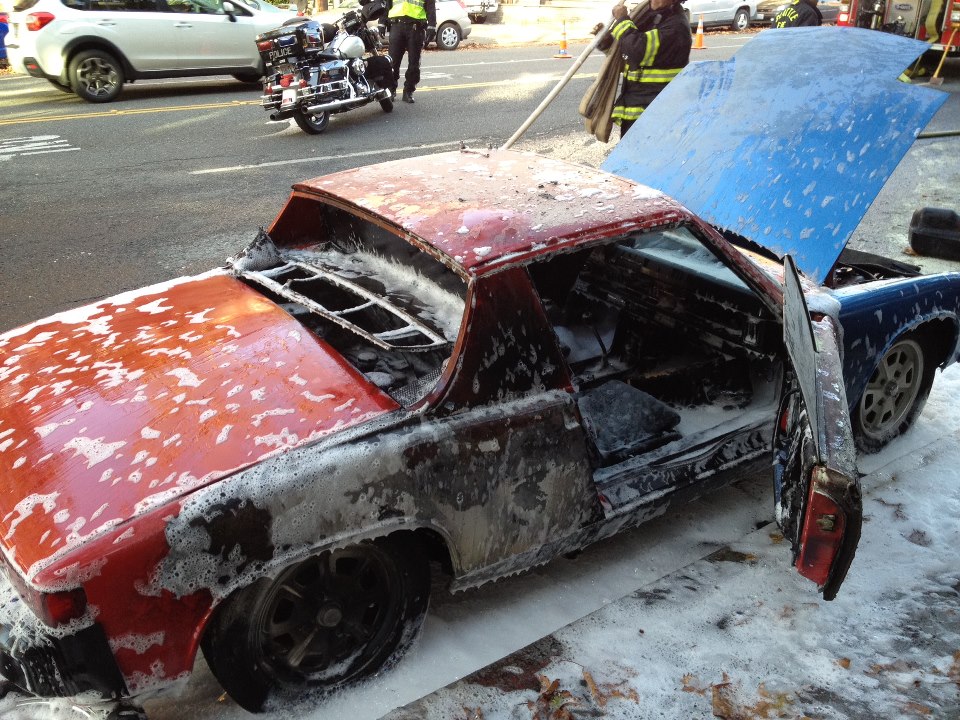
Video of car on fire: https://www.facebook.com/photo.php?v=10151125433882341
This is an unfortunate, serious reality and real danger for us 914 owners that tragically happens all too often. But why and how can it be prevented?
I'd like to propose three talking points that could help educate other 914 owners to make necessary precautions to preserve their cars - and their lives:
1. What causes fires in the 914 and why are they so common?
2. What precautions may be done to prevent a 914 from catching fire?
3. If your 914 does catch fire, should you try to put it out or should you stay away in case of an explosion?
Posted by: tumamilhem Dec 4 2012, 02:35 PM
I'll go first.
Fortunately, this has never happened to me. And I pray it never will. But what can be done to insure that from happening?
I understand that it is common for battery acid to drip onto the fuel lines below, that are made of plastic. The fuel lines are easily eaten by the acid and hold about 30 lbs. of pressure, making the fuel spray quickly onto the heaters, etc. and quickly igniting and spreading.
How can this be prevented? Can the fuel lines be coated or housed in something that the acid will not damage? Is there an acid-resistant replacement? Can an acid-resistant material line encase the battery (or at least on the tray) to prevent leakage?
Also, is it possible for a 914 to catch fire while parked (not turned on)? Say, parked on the street or God forbid, sitting in your garage?
Posted by: billh1963 Dec 4 2012, 02:43 PM
Wonder how much he wants for those fuchs? ![]()
Posted by: tumamilhem Dec 4 2012, 02:46 PM
Oh that's just wrong. :/
The guy said he had just bought this car too. ![]()
Posted by: zymurgist Dec 4 2012, 02:51 PM
The plastic fuel lines in the tunnel are 40 years old. If you ever have to remove the originals, don't put them back! There are vendors selling stainless steel fuel lines that go through the center tunnel. Also, if you still have fuel injection, be sure to get FI rated hose because of the higher fuel pressure than that used by carbureted engines.
Posted by: tumamilhem Dec 4 2012, 02:56 PM
Where can I find these stainless fuel lines and hoses should I need to have them replaced?
Posted by: JawjaPorsche Dec 4 2012, 03:00 PM
Pelican Parts sells them.
Where can I find these stainless fuel lines and hoses should I need to have them replaced?
Posted by: Cairo94507 Dec 4 2012, 03:01 PM
Tangerine racing: http://tangerineracing.com/stainlessFuelLines.htm
I got my SS fuel line from them and they are very nice. Cheapest insurance you can buy for your car. I am also adding a basic fire suppression system into the build of my car for a little added safety.
Posted by: tumamilhem Dec 4 2012, 03:03 PM
What is a basic fire suppression system? Where can it be found and how to install?
Thank you guys for all of your input! Any other reasons a 914 may catch fire or how to prevent?
Posted by: nathansnathan Dec 4 2012, 03:11 PM
This is a problem for vw buses also, which don't have the plastic lines.
I would say the problem is fuel filters with worm-drive clamps dangling from braided line right next to the coil or plug wires.
I had an inlet banjo come loose on a set of dells, dripping fuel. I actually shorted out the electric fuel pump for the carbs, but no fire.
What you need to start a fire I think is full on spray going onto a sparkplug wire or the coil.
Prevention would include keeping fuel filters out of the engine compartment, using the right clamps, securing fuel lines with zip ties, and running ethanol rated 30R9 lines, besides just replacing the plastic lines in the tunnel.
Posted by: tumamilhem Dec 4 2012, 03:17 PM
This is a problem for vw buses also, which don't have the plastic lines.
I would say the problem is fuel filters with worm-drive clamps dangling from braided line right next to the coil or plug wires.
I had an inlet banjo come loose on a set of dells, dripping fuel. I actually shorted out the electric fuel pump for the carbs, but no fire.
What you need to start a fire I think is full on spray going onto a sparkplug wire or the coil.
Prevention would include keeping fuel filters out of the engine compartment, using the right clamps, securing fuel lines with zip ties, and running ethanol rated 30R9 lines, besides just replacing the plastic lines in the tunnel.
Would these ethanol rated 30R9 lines be the same thing as the SS steel lines?
What kind of clamps should be used (and for what)?
What purpose does sip tying the fuel lines serve?
I'm not so mechanically inclined as you guys, so I'm trying to learn and understand to prevent this from happening.
Thanks again!
Posted by: zymurgist Dec 4 2012, 03:24 PM
Tangerine racing: http://tangerineracing.com/stainlessFuelLines.htm
I got my SS fuel line from them and they are very nice. Cheapest insurance you can buy for your car. I am also adding a basic fire suppression system into the build of my car for a little added safety.
Posted by: Cap'n Krusty Dec 4 2012, 03:25 PM
This has been a problem since the cars came onto the market. Bad hoses, incorrect hose and/or hose inner diameter, wrong hose clamps. It's virtually NEVER the plastic lines. We do SERVICES, NOT "tune-ups! We check for stuff like that every time the car is in. That's always been my practice, and any good shop will do the same. Fuel fires can be prevented by frequent inspections by both the owner and/or the shop he/she takes the car to for repairs.
The Cap'n
Posted by: jimkelly Dec 4 2012, 03:45 PM
my understanding is that when magnesium catches fire - its a bitch to put out.
so my understanding si the problem may start with leak in fuel lines but quickly turn to magnesium BURNING OUT OF CONTROL.
Posted by: Johny Blackstain Dec 4 2012, 03:50 PM
Magnesium can burn under water so if it lights there's no putting it out as far as i know. ![]()
Posted by: boogie_man Dec 4 2012, 03:52 PM
I'm not sure but, did you see the car lurching forward, then backward?
Doesn't look like the firefighters did that.. ![]()
Posted by: nathansnathan Dec 4 2012, 03:58 PM
This is a problem for vw buses also, which don't have the plastic lines.
I would say the problem is fuel filters with worm-drive clamps dangling from braided line right next to the coil or plug wires.
I had an inlet banjo come loose on a set of dells, dripping fuel. I actually shorted out the electric fuel pump for the carbs, but no fire.
What you need to start a fire I think is full on spray going onto a sparkplug wire or the coil.
Prevention would include keeping fuel filters out of the engine compartment, using the right clamps, securing fuel lines with zip ties, and running ethanol rated 30R9 lines, besides just replacing the plastic lines in the tunnel.
Would these ethanol rated 30R9 lines be the same thing as the SS steel lines?
What kind of clamps should be used (and for what)?
What purpose does sip tying the fuel lines serve?
I'm not so mechanically inclined as you guys, so I'm trying to learn and understand to prevent this from happening.
Thanks again!
The deal is that ethanol is like alcohol and will dry out hoses. 30R9 is an SAE rating for fuel hose that has a silicone-like 'flouroelastomer' lining that is resistant. It used to be blue on the inside but it's all just black now, looks like non braided line, so you have to look for 30R9 to be printed - it is for high pressure and it is expensive. You will only find it in english sizes since ethanol is an american problem.
The deal with the clamps is that the slots that worm drive (normal) hose clamps use will bite int the hose ends and make the drying cracking worse there at the ends, that is where they break, fuel lines. Proper clamps don't have as much range of adjustment. The old vw ones have a flange to protect the edges, mercedes ones are alright too. The difference is the slots all the way around.
About zip ties, it is the flopping around/moving that will cause the breaking once the clamps and the ethanol have made the lines brittle.
The worst situation to have is braided line, not zip tied, with regular hose clamps, the fuel filter flopping about right by the coil.
Posted by: Cairo94507 Dec 4 2012, 04:04 PM
I have yet to locate the system that will be installed in my car. I remember looking about a year ago but figured I would wait until we were closer to the time we actually needed it. I think $500 can buy a basic system with a few nozzles to locate in the engine compartment.
Posted by: tumamilhem Dec 4 2012, 04:24 PM
Magnesium can burn under water so if it lights there's no putting it out as far as i know.
What psrts are magnesuim that will cstch fire?
Posted by: tumamilhem Dec 4 2012, 04:28 PM
This is a problem for vw buses also, which don't have the plastic lines.
I would say the problem is fuel filters with worm-drive clamps dangling from braided line right next to the coil or plug wires.
I had an inlet banjo come loose on a set of dells, dripping fuel. I actually shorted out the electric fuel pump for the carbs, but no fire.
What you need to start a fire I think is full on spray going onto a sparkplug wire or the coil.
Prevention would include keeping fuel filters out of the engine compartment, using the right clamps, securing fuel lines with zip ties, and running ethanol rated 30R9 lines, besides just replacing the plastic lines in the tunnel.
Would these ethanol rated 30R9 lines be the same thing as the SS steel lines?
What kind of clamps should be used (and for what)?
What purpose does sip tying the fuel lines serve?
I'm not so mechanically inclined as you guys, so I'm trying to learn and understand to prevent this from happening.
Thanks again!
The deal is that ethanol is like alcohol and will dry out hoses. 30R9 is an SAE rating for fuel hose that has a silicone-like 'flouroelastomer' lining that is resistant. It used to be blue on the inside but it's all just black now, looks like non braided line, so you have to look for 30R9 to be printed - it is for high pressure and it is expensive. You will only find it in english sizes since ethanol is an american problem.
The deal with the clamps is that the slots that worm drive (normal) hose clamps use will bite int the hose ends and make the drying cracking worse there at the ends, that is where they break, fuel lines. Proper clamps don't have as much range of adjustment. The old vw ones have a flange to protect the edges, mercedes ones are alright too. The difference is the slots all the way around.
About zip ties, it is the flopping around/moving that will cause the breaking once the clamps and the ethanol have made the lines brittle.
The worst situation to have is braided line, not zip tied, with regular hose clamps, the fuel filter flopping about right by the coil.
So don't use steel braided line, use 30R9 lines instead? What do they cost and whete can they bevfound?
What kind of hoses and clamps should be used and where can they be found?
Posted by: tumamilhem Dec 4 2012, 04:30 PM
And what size 30R9 lines for 2.0 stock?
Posted by: rgolia Dec 4 2012, 04:48 PM
I lost 8 gallons of gas in 3 city blocks in the south Bronx back in 1977 (the car was 3 years old). Do not know how it did not go up in flames, but I had to keep driving or the car would have been on cinder blocks and stripped to the bare metal within 2 minutes of being left on the side of the road if you know the south Bronx. Made it back to dads shop and did the repairs in his dirt lot.....then Porsche sends out the recall notice.....nice.
Posted by: Hammy Dec 4 2012, 05:04 PM
This is a problem for vw buses also, which don't have the plastic lines.
I would say the problem is fuel filters with worm-drive clamps dangling from braided line right next to the coil or plug wires.
I had an inlet banjo come loose on a set of dells, dripping fuel. I actually shorted out the electric fuel pump for the carbs, but no fire.
What you need to start a fire I think is full on spray going onto a sparkplug wire or the coil.
Prevention would include keeping fuel filters out of the engine compartment, using the right clamps, securing fuel lines with zip ties, and running ethanol rated 30R9 lines, besides just replacing the plastic lines in the tunnel.
I also agree like Cap'n said that the fuel lines down the tunnel are rarely the problem. I replaced mine with SS just to be safe.
Cheap fuel filters (in wrong and hot places), incorrect fuel hose size (and wrong type), wrong hose clamps, incorrect/lazy hose routing, etc.. Also leaky carbs. Even the stock injectors/rails are finicky and will leak if hoses are not clamped down correctly. Always go through the fuel system on a just purchased car, never know what the PO did.
Posted by: ellisor3 Dec 4 2012, 05:10 PM
Here is link to some fire supression systems.
https://www.pegasusautoracing.com/group.asp?GroupID=FIREAUTO
I only use fuel injection hose clamps that designed specifically for each hose diameter. As stated, do not use worm clamps. I know the Capt'n says he has not seen problem with the plastic lines, but why take a chance, replace them with SS. Even if you don't go to a full fire supression system, at a minimum put a fire extinguisher in your car.
I had a friend who's car caught on fire and he tried to put it out, but when the police came, they made him stop for his own protection. They did not attempt to fight the fire.
Posted by: nathansnathan Dec 4 2012, 05:12 PM
And what size 30R9 lines for 2.0 stock?
Here's a thread on it. I think the sizes are the same for the 2.0 as the 1.7?
http://www.914world.com/bbs2/index.php?showtopic=112825
The challenge is to get the right size in inches; it's going to be slightly different than the metric. I haven't got my fuel lines replaced yet so I can't help too much.
Posted by: brant Dec 4 2012, 05:32 PM
my understanding is that when magnesium catches fire - its a bitch to put out.
so my understanding si the problem may start with leak in fuel lines but quickly turn to magnesium BURNING OUT OF CONTROL.
The mag tranny cases really are not a concern
I've tested pieces of a case and it takes much more heat than I could find to light them... A welding torch won't light the case
if that car in the picture had lit its mag tranny case there would be no trunk lid left...
its the gasoline that is more flamable than the mag tranny case.
hazmat has a rating system about how flamable something is. It is measured in degree's of heat it would take to ignite it. By the time a tranny were to catch fire, there would be no car left as all of the body would be melted away, the fire having totaled the whole car long before the tranny became flammable.
brant
Posted by: Cap'n Krusty Dec 4 2012, 05:53 PM
This is a problem for vw buses also, which don't have the plastic lines.
I would say the problem is fuel filters with worm-drive clamps dangling from braided line right next to the coil or plug wires.
I had an inlet banjo come loose on a set of dells, dripping fuel. I actually shorted out the electric fuel pump for the carbs, but no fire.
What you need to start a fire I think is full on spray going onto a sparkplug wire or the coil.
Prevention would include keeping fuel filters out of the engine compartment, using the right clamps, securing fuel lines with zip ties, and running ethanol rated 30R9 lines, besides just replacing the plastic lines in the tunnel.
Would these ethanol rated 30R9 lines be the same thing as the SS steel lines?
What kind of clamps should be used (and for what)?
What purpose does sip tying the fuel lines serve?
I'm not so mechanically inclined as you guys, so I'm trying to learn and understand to prevent this from happening.
Thanks again!
The deal is that ethanol is like alcohol and will dry out hoses. 30R9 is an SAE rating for fuel hose that has a silicone-like 'flouroelastomer' lining that is resistant. It used to be blue on the inside but it's all just black now, looks like non braided line, so you have to look for 30R9 to be printed - it is for high pressure and it is expensive. You will only find it in english sizes since ethanol is an american problem.
The deal with the clamps is that the slots that worm drive (normal) hose clamps use will bite int the hose ends and make the drying cracking worse there at the ends, that is where they break, fuel lines. Proper clamps don't have as much range of adjustment. The old vw ones have a flange to protect the edges, mercedes ones are alright too. The difference is the slots all the way around.
About zip ties, it is the flopping around/moving that will cause the breaking once the clamps and the ethanol have made the lines brittle.
The worst situation to have is braided line, not zip tied, with regular hose clamps, the fuel filter flopping about right by the coil.
So don't use steel braided line, use 30R9 lines instead? What do they cost and whete can they bevfound?
What kind of hoses and clamps should be used and where can they be found?
SS braided fuel lines, just like the oil lines, are prone to developing leaks, especially at the fittings. Not good.
The Cap'n
Posted by: nathansnathan Dec 4 2012, 05:57 PM
I've seen pics where the magnesium fan housing is like gone. I've heard stories of how there is a special truck that they might/ might not even call if the magnesium is burning. I've heard they will probably just let it burn.
bus engine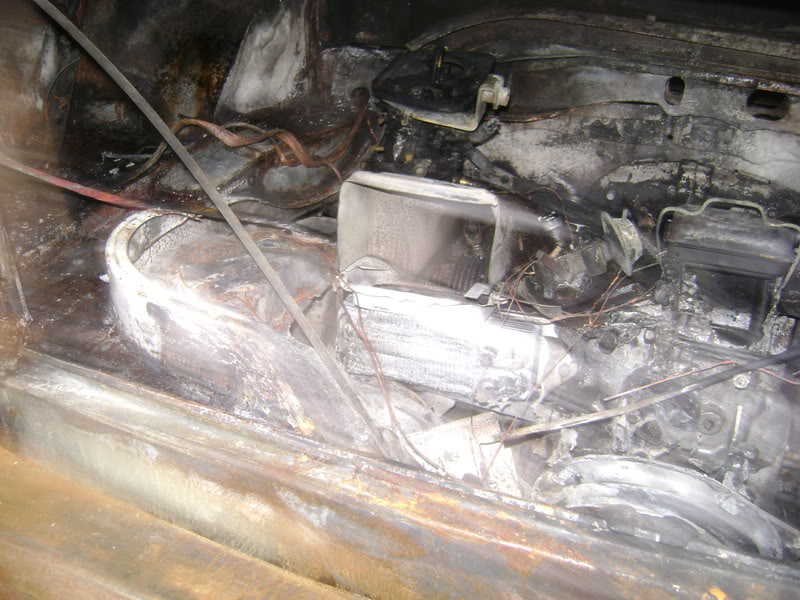
Posted by: tumamilhem Dec 4 2012, 06:32 PM
Damn, that's scary. :/
Posted by: Bruce Hinds Dec 4 2012, 06:47 PM
Dang, all this chatter and nobody mentioned the ignition source. Like leaking exhaust gaskets.
Especially when the fuel injector lines leak down over a leaking gasket. It only takes one backfire which it will do when you are decelerating.
smell fuel, find it and fix it . . . same with the exhaust.
Posted by: Katmanken Dec 4 2012, 07:06 PM
I actually watched one go up in flames while it was sitting at a traffic light. Car was idling fine, and then smoke appeared out of the engine compartment. The smoke increased, gas began pouring out from under the engine, and flames gradually appeared out of the intake grill.
Engine kept idling fine. Owner looked in the rear view mirror, did a double take, and jumped out of the car.
The rain tray began melting and burning and dropped in. The owner tried to open the engine intake grill- but by then, the latch quit working.
Flames shot out of the grill, the owner opened the trunk and pried the intake grill open with a crowbar.
Flames really shot out and the gas under the car caught fire....
The owner backed up, and finally killed the engine (which was running fine). By then, the fuel lines were broached under the car, and gas kept pouring out from underneath.
The flaming gas pool under the car increased, and caught the rear tires on fire. The flaming rear tires began to expand as the air inside heated. The rear of the car rose up as the tires got giant sized, and one by one, the rear tires blew.
The fire department arrived, and put it out with foam. At no time did I see any energetic magnesium burns.
I believe that a fuel line or injector J tube split on top of the engine, or a hose clamp let go. That sprayed a small stream of gasoline across the warm engine, and eventually it caught fire. Once the fire got going, the upper fuel line ruptured (after the pressure regulator?) to pour gas onto the top of the engine and under the car. The fuel pool under the car eventually caught fire and burned out the lower rubber fuel lines and/or gas filter. Once the lower hoses failed, there was no stopping the gravity fed fuel pouring from the gas tank.
Considering the number of cars I‘ve seen with petrified wooden-like rubber fuel lines or cheap assed low pressure fuel lines, it's a wonder more don't go up.
Cheap insurance is replacing 20-40 year old rubber fuel lines and injector "J" hoses, making sure that all fuel line clamps are the factory recommended ones (rolled edges) and that all clamps are tight. And don't cheapen out. BUY THE EXPENSIVE BUT SAFE HIGH PRESSURE FUEL LINE.
Posted by: URY914 Dec 4 2012, 07:14 PM
The fan housing on a Type IV is aluminum. It melts. How did this turn into a mag fire issue? ![]()
Posted by: tumamilhem Dec 4 2012, 08:44 PM
I actually watched one go up in flames while it was sitting at a traffic light. Car was idling fine, and then smoke appeared out of the engine compartment. The smoke increased, gas began pouring out from under the engine, and flames gradually appeared out of the intake grill.
Engine kept idling fine. Owner looked in the rear view mirror, did a double take, and jumped out of the car.
The rain tray began melting and burning and dropped in. The owner tried to open the engine intake grill- but by then, the latch quit working.
Flames shot out of the grill, the owner opened the trunk and pried the intake grill open with a crowbar.
Flames really shot out and the gas under the car caught fire....
The owner backed up, and finally killed the engine (which was running fine). By then, the fuel lines were broached under the car, and gas kept pouring out from underneath.
The flaming gas pool under the car increased, and caught the rear tires on fire. The flaming rear tires began to expand as the air inside heated. The rear of the car rose up as the tires got giant sized, and one by one, the rear tires blew.
The fire department arrived, and put it out with foam. At no time did I see any energetic magnesium burns.
I believe that a fuel line or injector J tube split on top of the engine, or a hose clamp let go. That sprayed a small stream of gasoline across the warm engine, and eventually it caught fire. Once the fire got going, the upper fuel line ruptured (after the pressure regulator?) to pour gas onto the top of the engine and under the car. The fuel pool under the car eventually caught fire and burned out the lower rubber fuel lines and/or gas filter. Once the lower hoses failed, there was no stopping the gravity fed fuel pouring from the gas tank.
Considering the number of cars I‘ve seen with petrified wooden-like rubber fuel lines or cheap assed low pressure fuel lines, it's a wonder more don't go up.
Cheap insurance is replacing 20-40 year old rubber fuel lines and injector "J" hoses, making sure that all fuel line clamps are the factory recommended ones (rolled edges) and that all clamps are tight. And don't cheapen out. BUY THE EXPENSIVE BUT SAFE HIGH PRESSURE FUEL LINE.
Holy shit. All this makes me want to redo all hoses, lines, anything to prevent this from happening. I just bought a 914 LE. Haven't received it yet. Will have to see what needs to be upgraded to give me some peace of mind.
Posted by: RickS Dec 4 2012, 09:05 PM
A halon extinguisher is the next best thing to a fire suppression system. Conventional extinguishers can't hold a proverbial candle to halon for gas fires. I keep one in easy reach just in case. Also have a red top battery, so no acid leaks, and ss fuel lines so my only worries are people texting and swilling lattes while slapping their brats.
Posted by: rdauenhauer Dec 4 2012, 09:30 PM
The Cap'n
My personal experience on this topic is pretty spot on as the description by the katman except for the ignition source.
Paul The Fan shroud *IS* Mag and once lit will burn like a Mother!!
Posted by: Dr Evil Dec 4 2012, 09:52 PM
I have never been able to ignite tranny cases. I have tried. As stated, the whole car will be gone at those heats.
Just assure your fuel system is up to snuff and you will be fine. Fuel needs to be out of the lines, onto something hot or a spark to cause the fire. Stop that and you are good.
Posted by: carr914 Dec 4 2012, 10:04 PM
Magnesium can burn under water so if it lights there's no putting it out as far as i know.
Foam & a lot of it. When my 73 caught fire the Mayberry FD tried Water & that made it worse. They finally used an unbelievable amount of Foam, but by then the Motor & Tranny had burned away - the only thing left was the Jet-Hot Coated Headers & 1 Velocity Stack. Even the Steering Wheel melted!
Posted by: GeorgeRud Dec 4 2012, 10:07 PM
Halon has the least cleanup, but foam is probably the best way to go. You might want to check on the Fire Fight website for extinguisher options. They sell mainly to the RV crowd, but have quite a few options.
Posted by: tumamilhem Dec 4 2012, 10:21 PM
Where is the fuel pump located on a '74? I have a '75 and it's located under the bonnet. I know it was moved up front in later years from the engine compartment due to freezing up, but when? I just bought a '74.
Posted by: GeorgeRud Dec 4 2012, 10:28 PM
74 is in back under passenger side engine shelf.
Posted by: tumamilhem Dec 4 2012, 10:44 PM
So it should be moved then I suppose? What do I need to do to relocate it to the front?
Posted by: stateofidleness Dec 4 2012, 11:25 PM
So it should be moved then I suppose? What do I need to do to relocate it to the front?
Subscribed for answer to this.
Got the SS lines a long time ago (haven't installed) and all new fuel lines, but have been wanting to relocate the pump up front on my '73.
Posted by: montoya 73 2.0 Dec 4 2012, 11:29 PM
It looks as though they used foam on that Teener. I personaly had my teener catch fire but it was in the steering column. Back in 1998 when my pops owned the car, I was driving it because my bus wasn't working. The wipers didn't work at the time due to a bad motor. I must have accidentally turned the wipers on when making a turn and never turned them off. As I was a block away from home i smell burning plastic and then smoke started pouring out of steering column. Luckily the p.o. before my pops installed a halon 2.5 lb extinguisher in the cab. I reached over while driving grabbed the extinguisher, reached down under the dash and squeezed the trigger a few times then brought it up in front of me and squeezed a few times. Luckily it was a warm day in san jose california that day so I had my window down cause it got cloudy and halon sucks the o2 out of the direct area. It went out and I had reached home and turned it off. We had it towed to the shop in fremont and thats when we found out it was due to a electrical fire. So it is not always a gas fire.
Also, back in the 80's we would go to boney dunes near santa cruz and use a old 36 horse vw motor block that is magnesium in the center of the wood pile and light it up! That block would glow and you would have to stand a good 15 to 20 feet away. I bet it could turn some of that sand into glass. Magnesium won't light up in solid form unless it in a prolonged very hot fire but it will in shavings or dust form as in a machine shop situation. Atleast thats in my experience.
Posted by: maxwelj Dec 5 2012, 02:52 PM
To answer the question about catching fire while parked, I seem to remember an earlier thread from one of our members in which the car caught fire as it sat in his carport. A cursory search didnt find it, but maybe somebody else remembers who it was.
Posted by: 76-914 Dec 5 2012, 03:59 PM
I'll add one, albeit in "left field". Static discharge. Something I learned when flying experimental. Ordinarily this is not a concern as we usually pump from metal nozzles that are grounded. But I'll bet I have had the tanks in & out of my 914's a dozen times. When I drain my tank I actually siphon the gas into a DOT gas can then pour it back in the tank when finished. Sound familiar? Then your playing with fire my friend. I know of 2 planes that burned to the ground being re-fueled this way. Best chance of this happening is where one lives in an arid climate.( or a just a low humidity day where you live). Couple that with a plastic gas can sliding across your pick up bed, rubbing against your jeans or wool shirt and you've got a ticking time bomb. As soon as that spout gets near the metal filler neck ![]() . It only takes a second to discharge any static buildup. Before lifting the can off the floor pour a bit of water on the side of the can. When the water comes in contact with the ground and gas can it is grounded and discharged. Easier than attaching a damned ground cable.
. It only takes a second to discharge any static buildup. Before lifting the can off the floor pour a bit of water on the side of the can. When the water comes in contact with the ground and gas can it is grounded and discharged. Easier than attaching a damned ground cable. ![]() I know I'm reaching but if this saves one teener, so be it.
I know I'm reaching but if this saves one teener, so be it.
Posted by: Ductech Dec 5 2012, 04:12 PM
I remember a v8 conversion that caught fire in a parking lot while off... Maybe a year ago. This Is on of the reasons why racers install big power cutoff switches. I have one and store my subie conversion with the battery disconnected via one of these switches. Only my starter and alternator stay connected to the battery. Everything else is after the master cutoff. Bottom line know what your doing when it comes to electrical. It can start a fire really quick!
Posted by: ClayPerrine Dec 5 2012, 06:10 PM
This is from personal experience......
Betty and I were living in Arlington, and we were driving her car from there to my parent's house in Bedford. On the way up Hwy 360, I hear her yell "Were on FIRE!".
The car didn't lose power, so I quickly moved right and got it on the shoulder. We bailed out, and I tried to put the fire out with a handheld extinguisher. I just slowed it down.
The FD arrived, and used a half of the water in the tanker and two big CO2 extinguishers to get the fire put out. By that time the top had collapsed inward, the interior was gone, the gauge lenses had bubbled out, and the windshield collapsed inward.
After it cooled, the fire marshall did a post mortem. His analysis was that the plastic pressure line had split at the firewall where it makes the turn to the right, and sprayed gas all over the hot heat exchangers, starting the fire.
That engine fire almost cost me my marriage, as that is Betty's pride and joy.
It took me a few years to get it back up and running.
To this day, I will never own a 914 that has the plastic lines, and I will gladly install steel lines for free for anyone who is willing to pay the cost of the lines. I don't ever want to see another 914 on fire.
Posted by: struckn Dec 5 2012, 07:58 PM
This is a problem for vw buses also, which don't have the plastic lines.
I would say the problem is fuel filters with worm-drive clamps dangling from braided line right next to the coil or plug wires.
I had an inlet banjo come loose on a set of dells, dripping fuel. I actually shorted out the electric fuel pump for the carbs, but no fire.
What you need to start a fire I think is full on spray going onto a sparkplug wire or the coil.
Prevention would include keeping fuel filters out of the engine compartment, using the right clamps, securing fuel lines with zip ties, and running ethanol rated 30R9 lines, besides just replacing the plastic lines in the tunnel.
I also agree like Cap'n said that the fuel lines down the tunnel are rarely the problem. I replaced mine with SS just to be safe.
Cheap fuel filters (in wrong and hot places), incorrect fuel hose size (and wrong type), wrong hose clamps, incorrect/lazy hose routing, etc.. Also leaky carbs. Even the stock injectors/rails are finicky and will leak if hoses are not clamped down correctly. Always go through the fuel system on a just purchased car, never know what the PO did.
Ethanol is relatively new to fuel and a problem that may now cause the original plastic lines in the tunnel to fail. Rarely a problem in the past is not a good arguement in favor of not replacing the old plastic lines.
Posted by: tumamilhem Dec 6 2012, 04:20 PM
Suppression system aside do to high cost, what kind of fire extinguisher should be used to keep in the car? I understand there are different kinds.
Posted by: iamchappy Dec 6 2012, 04:25 PM
SS lines are a must, and this is piece of mind....
Attached image(s)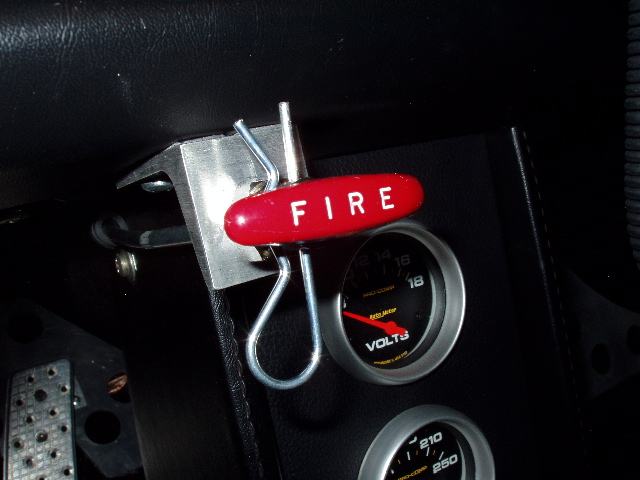
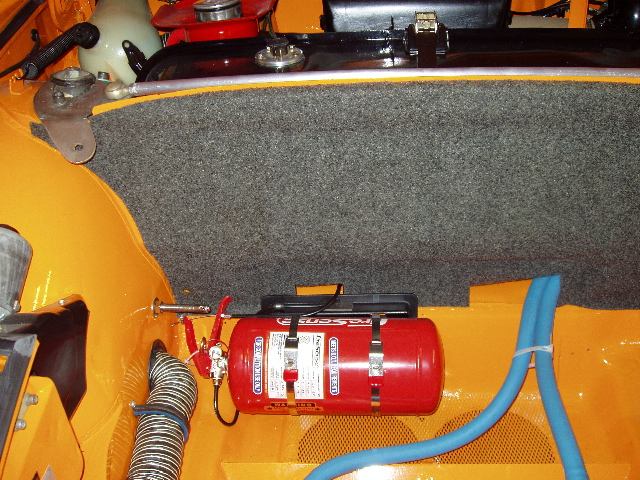
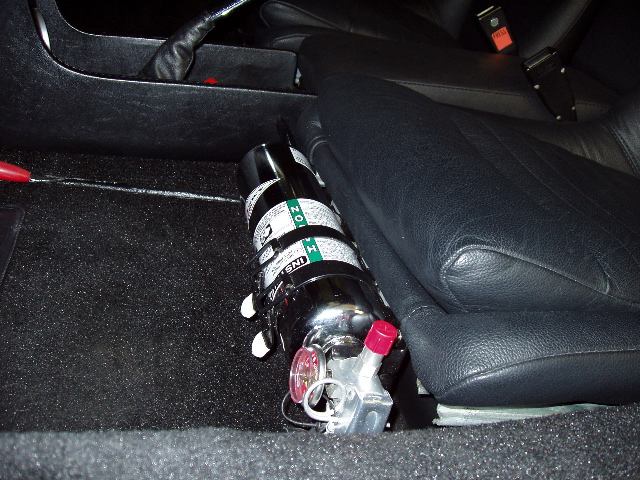
Posted by: nathansnathan Dec 6 2012, 08:10 PM
Suppression system aside do to high cost, what kind of fire extinguisher should be used to keep in the car? I understand there are different kinds.
They rate them by A, B, and C. C is what you need to put out a gasoline fire. Halon is nice, but expensive, as it doesn't make a crazy mess like the dry stuff.
I will never forget the time I fire extinguisher'd my mom's toaster oven as a kid. I had burnt some pop tarts and opened the door, the oxygen , and they burst into flames. I probably could have just shut the door, but instead I filled the whole house with white powder. The toaster oven was ruined. Man, was my mom pissed!
Posted by: Dr Evil Dec 6 2012, 08:44 PM
B is what you need for gasoline. C is for electrical. A is for anything that leaves an ash, but does not have current going through it (so can be a water extinguisher).
Halon is the best as it does not ruin what is left of what you are putting out and is ABC rated. Powder extinguishers are good for gasoline, but the powder corrodes the shit out of all metals that are left behind so while your car was put out, the left overs are seriously shot.
Posted by: carr914 Dec 6 2012, 08:51 PM
Ethanol is relatively new to fuel and a problem that may now cause the original plastic lines in the tunnel to fail. Rarely a problem in the past is not a good arguement in favor of not replacing the old plastic lines.
While Ethanol sucks, it is more a problem for Rubber Lines. The Plastic Lines are the PROBLEM - they are OLD.
Posted by: nathansnathan Dec 6 2012, 09:01 PM
B is what you need for gasoline. C is for electrical. A is for anything that leaves an ash, but does not have current going through it (so can be a water extinguisher).
Halon is the best as it does not ruin what is left of what you are putting out and is ABC rated. Powder extinguishers are good for gasoline, but the powder corrodes the shit out of all metals that are left behind so while your car was put out, the left overs are seriously shot.
Yep, my bad. It is the B that is important.
Posted by: Dr Evil Dec 6 2012, 09:05 PM
Bringing up my old Naval Firefighter knowledge ![]()
Posted by: Kirmizi Dec 6 2012, 10:01 PM
Bringing up my old Naval Firefighter knowledge
Doc, you've had fires in your belly button?
Posted by: scotty b Dec 6 2012, 10:11 PM
Bringing up my old Naval Firefighter knowledge
Doc, you've had fires in your belly button?
Posted by: Dr Evil Dec 7 2012, 08:33 AM
No, I capitalized the propped nouns do you would know that I was talking about a job title, not the fires I have had in my belly lint trap.
Posted by: Madswede Dec 7 2012, 01:21 PM
He did say "Naval" not "navel" ... ![]()
![]()
Posted by: Porsche930dude Dec 7 2012, 06:32 PM
the factory seam sealer puddy seems to be very flamable
Posted by: montoya 73 2.0 Dec 7 2012, 10:48 PM
I replaced my home extinguishers (powder) to CO2. I was talking with the local fire extinguisher place and he was telling me that halon is still available but is twice as much as CO2 these days. A 5lb. CO2 cost me 150.00 bucks and it should also work for gasoline fires as well as electrical.
Posted by: Dr Evil Dec 8 2012, 12:07 PM
CO2 removes O2 and heat from the equation so as long as there is no constant heat source you can put out a class B fire. You can also use it to put out electrical fires, and it wont ruin what is left like the powder ones will.
Posted by: Drums66 Dec 8 2012, 06:30 PM
.....Pass me another hotdog.......mine got burned!! ![]()
![]()
![]()
![]() (&&&...the halon)
(&&&...the halon)
Posted by: gaspump Dec 8 2012, 08:57 PM
Now you guys have me all shook up. I'm going to look at my first 914 tomorrow and it might catch fire. ![]() What plastic lines are we talking about? One's from the gas tank to the carbs or FI, or not? Or from the fuel pump to them? Oh well, I've got a lot to learn about these cars. If I get it, I'll post some pics.
What plastic lines are we talking about? One's from the gas tank to the carbs or FI, or not? Or from the fuel pump to them? Oh well, I've got a lot to learn about these cars. If I get it, I'll post some pics. ![]()
Posted by: Porschef Dec 9 2012, 07:39 AM
The factory fuel lines are a combination of nylon and steel. Somewhere in the tunnel they transition from steel to plastic. They head out the firewall, make a left (go to the right as you face the car from the back), pop up out of the right side engine shelf through two black rubber grommets, feed the fuel system, and return excess fuel back to the tank.
It is just as they exit that shelf where the problem lies, right under the battery. I replaced mine with Tangerine's excellent kit, and it wasn't until I removed the factory units that I saw how rough and BRITTLE they were at that spot. How? During the removal process I had to bend the plastic there just a bit. It kinked easily, and upon restraightening, cracked. Did I figure if it was the feed or the return that was really shot? No.
Sometimes, when I'm wondering if something is worthwhile doing, I'll ask myself "would I give (in this case, about 215 bux for SS lines and enough R9 to do the job) to have my car not catch on fire and possibly be completely destroyed? To have it back the way it was for the sake of not doing a relatively easy job as a precaution?...
Why even waste time talking about how you'd extinguish a fire?
Pretty simple answer, especially when you see the possible effects. ![]()
![]()
It's a nearly 40 year old German car. Expect it to need some updating.
Joe
Posted by: jim_hoyland Dec 9 2012, 08:48 AM
Some fires look like there's nothing that will put it out.... ![]()
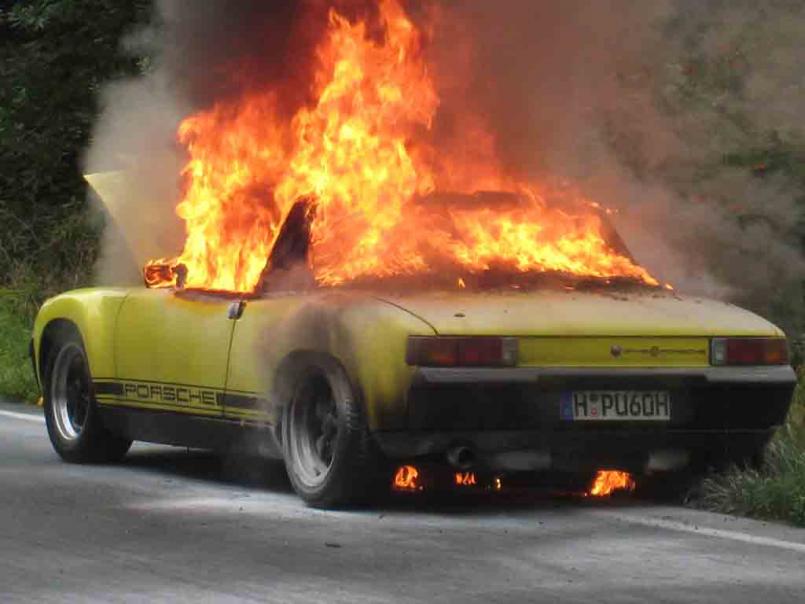
Posted by: tumamilhem Dec 9 2012, 10:17 AM
Damn. That's heartbreaking.
Posted by: Katmanken Dec 9 2012, 10:47 AM
I really hope nobody is using cable ties to secure fuel lines.
First, they can't tighten as much as a screw clamp.
Second, there is this little thing called "creep" with plastics. Creep is where you load a plastic part and it deforms or 'creeps" over time to a relaxed shape. For clamped cable ties tightened on fuel lines, that means they elongate until the tension in them reaches ZERO.
Once you hit zero tension, you might as well have left them off for all the good they will do you.
As a cable bundler they work great. As a high pressure hose clamp, they suck.
Posted by: john_g Dec 9 2012, 12:18 PM
Somebody send a photo of a good quality clamp, please?
Posted by: Katmanken Dec 9 2012, 01:34 PM
Here is the one supplied in the factory recall to fix the flaming 914 problem.
Note that unlike regualr hose clamps that have flat sharp edges, these have rolled edges.
Seems that the combo of clamping the the old style sharp edged hose clamps into place embedded the sharp edges into the fuel hose, and as the factory fuel hoses expanded from pressure and time, the old style sharp edges cut the fuel hose resulting in fuel sprays and fire.
Here is a link to another thread.http://www.914world.com/bbs2/index.php?showtopic=67843&st=0
Attached image(s)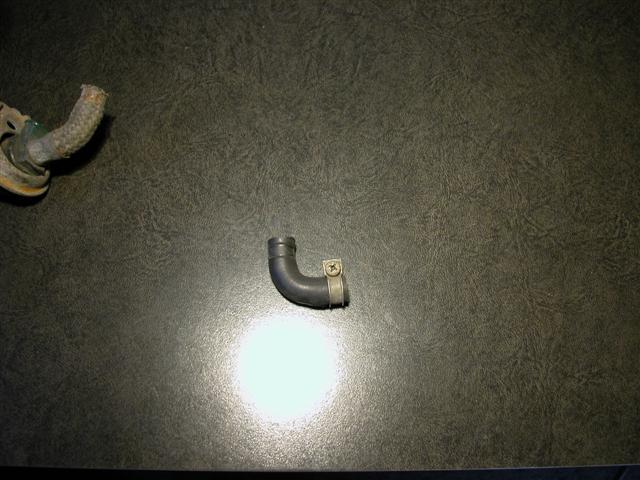
Posted by: nathansnathan Dec 9 2012, 02:06 PM
I really hope nobody is using cable ties to secure fuel lines.
First, they can't tighten as much as a screw clamp.
Second, there is this little thing called "creep" with plastics. Creep is where you load a plastic part and it deforms or 'creeps" over time to a relaxed shape. For clamped cable ties tightened on fuel lines, that means they elongate until the tension in them reaches ZERO.
Once you hit zero tension, you might as well have left them off for all the good they will do you.
As a cable bundler they work great. As a high pressure hose clamp, they suck.
By "secure" I mean attaching them so a they aren't flopping around in the middle. For the ends, yes, I would use something metal.
Posted by: tumamilhem Dec 12 2012, 01:10 PM
Not a good use of a 914 fire, but certainly more preferable than an unintended one. ![]()
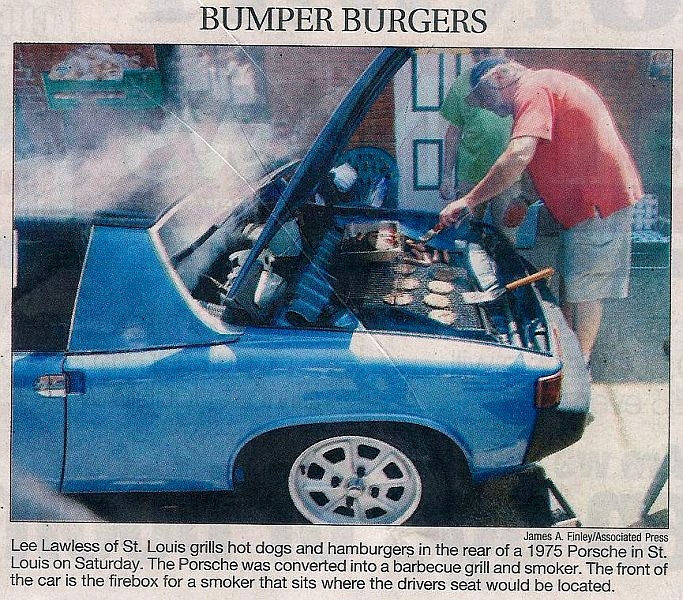
Posted by: tumamilhem Dec 12 2012, 01:11 PM
Maybe he could part out the rest. Look like it's in good shape, save the George Foreman. :/
Posted by: Jgilliam914 Dec 12 2012, 02:36 PM
I had a 72 with a 1.7 go up in smoke and flames in my garage in 1986. The magnesium was put out by a foam fire suppressant. The sparks and the color of the magnesium burning was pretty and it popped like popcorn. I am thankful the car had only had a gallon of gas in it. It was up on stands at the time. The fire Marshall was called in due to the insurance co. thinking I torched it. I had issues with the starter not disengaging and he thought that the heat from that with the fuel lines so close one ignited the other. Until then I had a 9 yr old nephew who had been known to light fires staying with me I thought he may have playing with matches. What was funny about this is that the Insurance investigator who thought I may have torched it ended up being my father in law 26 years later
Posted by: 914_teener Dec 12 2012, 02:52 PM
I had a 72 with a 1.7 go up in smoke and flames in my garage in 1986. The magnesium was put out by a foam fire suppressant. The sparks and the color of the magnesium burning was pretty and it popped like popcorn. I am thankful the car had only had a gallon of gas in it. It was up on stands at the time. The fire Marshall was called in due to the insurance co. thinking I torched it. I had issues with the starter not disengaging and he thought that the heat from that with the fuel lines so close one ignited the other. Until then I had a 9 yr old nephew who had been known to light fires staying with me I thought he may have playing with matches. What was funny about this is that the Insurance investigator who thought I may have torched it ended up being my father in law 26 years later
Now that is a story so unbelievable it has to be true!
Posted by: tumamilhem Dec 12 2012, 03:01 PM
I had a 72 with a 1.7 go up in smoke and flames in my garage in 1986. The magnesium was put out by a foam fire suppressant. The sparks and the color of the magnesium burning was pretty and it popped like popcorn. I am thankful the car had only had a gallon of gas in it. It was up on stands at the time. The fire Marshall was called in due to the insurance co. thinking I torched it. I had issues with the starter not disengaging and he thought that the heat from that with the fuel lines so close one ignited the other. Until then I had a 9 yr old nephew who had been known to light fires staying with me I thought he may have playing with matches. What was funny about this is that the Insurance investigator who thought I may have torched it ended up being my father in law 26 years later
Yeah, I've been wondering about this scenario. How does a car catch fire being parked and not on? Even if there is a fuel leak, there's nothing to ignite it. Concerned about mine in the garage now....
Posted by: Vacca Rabite Dec 12 2012, 08:48 PM
I had a 72 with a 1.7 go up in smoke and flames in my garage in 1986. The magnesium was put out by a foam fire suppressant. The sparks and the color of the magnesium burning was pretty and it popped like popcorn. I am thankful the car had only had a gallon of gas in it. It was up on stands at the time. The fire Marshall was called in due to the insurance co. thinking I torched it. I had issues with the starter not disengaging and he thought that the heat from that with the fuel lines so close one ignited the other. Until then I had a 9 yr old nephew who had been known to light fires staying with me I thought he may have playing with matches. What was funny about this is that the Insurance investigator who thought I may have torched it ended up being my father in law 26 years later
Yeah, I've been wondering about this scenario. How does a car catch fire being parked and not on? Even if there is a fuel leak, there's nothing to ignite it. Concerned about mine in the garage now....
Electrical short.
cracked insulators. Mice. Storm damage, etc. Hot wire touched ground and makes a nice spark or shorts and holds and heats up till it melts to slag. Hot enough to catch paper or foam or insulation on fire. Poof, car goes up.
Easy to keep that from happening though. Unplug the battery when you are storing it for a long time. no battery, no issues.
Compared to leaky gas lines, big electrical fires are rare. The gas lines are what you really have to take care of.
Zach
Powered by Invision Power Board (http://www.invisionboard.com)
© Invision Power Services (http://www.invisionpower.com)
